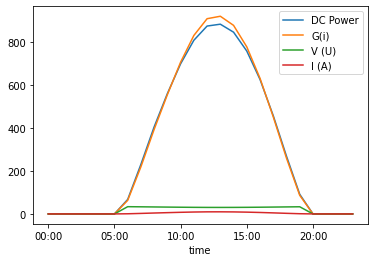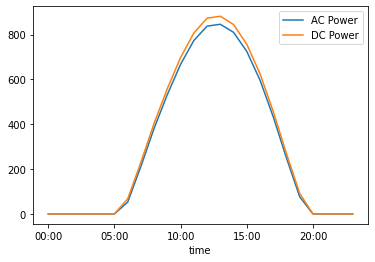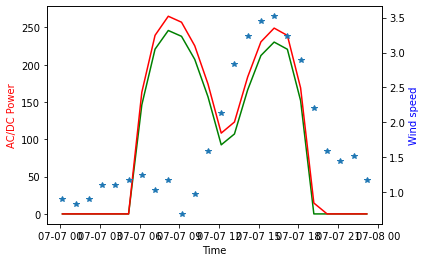A library used to simulate photovoltaic energy production using PVGIS
Project description
Defining the location
>>> from pvmodule.location import Location
>>> from pvmodule.pvgis import PVGIS
>>> Location = Location()
>>> location = Location.set_location('Lisbon')
>>> print(location.get_info())
{
'Address': 'Lisboa, Portugal',
'Latitude': 38.7077507,
'Longitude': -9.1365919,
'Elevation': 10.93380069732666,
'Timezone': 'Europe/Lisbon'
}
Retrieving Hourly data from PVGIS
>>> from pvmodule.location import Location
>>> from pvmodule.pvgis import PVGIS
>>> Location = Location()
>>> location = Location.set_location('Lisbon')
>>> PVGIS = PVGIS()
>>> input, output, meta = PVGIS.retrieve_hourly(
latitude=location.latitude,
longitude=location.longitude
)
>>> print(output)
G(i) H_sun T2m WS10m Int
time
2005-01-01 00:10:00 0.0 0.0 11.29 3.86 0.0
2005-01-01 01:10:00 0.0 0.0 11.19 4.14 0.0
2005-01-01 02:10:00 0.0 0.0 11.08 4.07 0.0
2005-01-01 03:10:00 0.0 0.0 10.94 3.66 0.0
2005-01-01 04:10:00 0.0 0.0 10.84 3.24 0.0
... ... ... ... ... ...
2020-12-31 19:10:00 0.0 0.0 12.50 8.28 0.0
2020-12-31 20:10:00 0.0 0.0 12.12 8.34 0.0
2020-12-31 21:10:00 0.0 0.0 11.58 8.48 0.0
2020-12-31 22:10:00 0.0 0.0 11.41 8.28 0.0
2020-12-31 23:10:00 0.0 0.0 11.36 8.14 0.0
[140256 rows x 5 columns]
Retrieving daily data from PVGIS (July)
>>> from pvmodule.location import Location
>>> from pvmodule.pvgis import PVGIS
>>> Location = Location()
>>> location = Location.set_location('Lisbon')
>>> PVGIS = PVGIS()
>>> input, output, meta = PVGIS.retrieve_daily(
latitude=location.latitude,
longitude=location.longitude,
month=6
)
>>> print(output)
month G(i) Gb(i) Gd(i) T2m
time
00:00 6 0.00 0.00 0.00 17.49
01:00 6 0.00 0.00 0.00 17.35
02:00 6 0.00 0.00 0.00 17.21
03:00 6 0.00 0.00 0.00 17.09
04:00 6 0.00 0.00 0.00 16.98
05:00 6 0.00 0.00 0.00 16.91
06:00 6 88.17 36.65 51.52 16.97
07:00 6 244.22 136.17 108.05 17.53
08:00 6 406.34 251.83 154.51 18.42
09:00 6 560.33 366.56 193.77 19.39
10:00 6 691.23 479.46 211.78 20.29
11:00 6 788.61 558.10 230.51 21.05
12:00 6 869.24 632.05 237.19 21.59
13:00 6 877.81 644.56 233.24 21.88
14:00 6 828.50 609.14 219.36 21.92
15:00 6 738.56 540.56 198.01 21.75
16:00 6 594.07 420.05 174.01 21.38
17:00 6 426.24 280.32 145.91 20.88
18:00 6 244.49 141.33 103.16 20.25
19:00 6 82.36 35.16 47.20 19.45
20:00 6 0.00 0.00 0.00 18.68
21:00 6 0.00 0.00 0.00 18.18
22:00 6 0.00 0.00 0.00 17.90
23:00 6 0.00 0.00 0.00 17.69
Retrieving Monthly data from PVGIS (July)
>>> from pvmodule.location import Location
>>> from pvmodule.pvgis import PVGIS
>>> Location = Location()
>>> location = Location.set_location('Lisbon')
>>> PVGIS = PVGIS()
>>> input, output, meta = PVGIS.retrieve_monthly(
latitude = location.latitude,
longitude = location.longitude,
startyear=2020,
endyear=2020
)
>>> print(output)
year month H(h)_m Hb(n)_m Kd T2m
0 2020 1 71.23 107.98 0.42 12.8
1 2020 2 98.98 131.26 0.38 13.8
2 2020 3 147.58 168.06 0.36 13.7
3 2020 4 157.34 145.53 0.42 14.8
4 2020 5 218.93 220.23 0.31 18.1
5 2020 6 231.53 235.23 0.30 18.7
6 2020 7 244.94 261.47 0.26 21.2
7 2020 8 208.59 217.80 0.30 20.6
8 2020 9 159.27 167.80 0.36 20.3
9 2020 10 117.98 143.74 0.39 17.1
10 2020 11 68.78 81.66 0.52 15.4
11 2020 12 63.66 93.93 0.46 12.9
from pvmodule.system import System
Defining the module setup
>>> from pvmodule.system import System
#if nothing is input, it will consider the default module with its parameters.
>>> system = System()
>>> module = system.module(modules_per_string=3)
>>> print(module)
{
"name": "LG_Neon_2_ LG350N1C-V5",
"height": 1.686,
"length": 1.016,
"width": 40,
"pdc": 350,
"umpp": 35.3,
"impp": 9.92,
"uoc": 41.3,
"isc": 10.61,
"NOCT": 42,
"tc_pmax": -0.36,
"tc_voc": -0.27,
"tc_isc": 0.03,
"modules_per_string": 3,
"number_of_strings": 1,
"losses": 0,
}
Calculating the DC power generated by the previous module setup.
>>> from pvmodule.pvgis import PVGIS
>>> input, output, metadata = PVGIS().retrieve_daily(
location.latitude,
location.longitude,
month=7
)
>>> from pvmodule.system import System
>>> system = System()
>>> system_dc = system.dc_production(module, output['T2m'], output['G(i)'])
>>> print(system_dc)
>>> import matplotlib.pyplot as plt
>>> system_dc.plot()
DC Power G(i) V (U) I (A)
time
00:00 0.000000 0.00 0.000000 0.000000
01:00 0.000000 0.00 0.000000 0.000000
02:00 0.000000 0.00 0.000000 0.000000
03:00 0.000000 0.00 0.000000 0.000000
04:00 0.000000 0.00 0.000000 0.000000
05:00 0.000000 0.00 0.000000 0.000000
06:00 67.326169 62.96 33.595611 0.668006
07:00 230.488507 219.26 33.025791 2.326349
08:00 404.612107 392.92 32.351774 4.168881
09:00 559.303225 554.33 31.698762 5.881441
10:00 697.667399 705.17 31.082645 7.481854
11:00 806.834702 829.20 30.569521 8.797812
12:00 872.878407 907.01 30.234656 9.623376
13:00 881.502513 918.44 30.153389 9.744648
14:00 844.397024 876.07 30.281072 9.295103
15:00 756.681707 776.12 30.630051 8.234633
16:00 624.646497 629.87 31.156362 6.682921
17:00 456.489476 450.85 31.809882 4.783519
18:00 268.290990 259.17 32.522560 2.749794
19:00 91.263308 86.35 33.204521 0.916173
20:00 0.000000 0.00 0.000000 0.000000
21:00 0.000000 0.00 0.000000 0.000000
22:00 0.000000 0.00 0.000000 0.000000
23:00 0.000000 0.00 0.000000 0.000000
Calculating the AC power generated by the previous module setup.
Using a default CECinverter from an included list.
>>> system = System()
#Wind consideration can be included
#system_ac = system.ac_production(module, output['T2m'], output['G(i)'], inverter, wind=True, wind_speed=output['WS10m'])
#system_dc_wind = system.dc_production(module, output['T2m'], output['G(i)'],wind=True, wind_speed=output['WS10m'], temp=True)
>>> inverter_list = system.list_inverters()
>>> inverter = system.select_inverter('ABB: PVI-3.0-OUTD-S-US-A [240V]')
>>> system_ac = system.ac_production(module, output['T2m'], output['G(i)'], inverter)
>>> print(system_ac)
>>> import matplotlib.pyplot as plt
>>> system_ac.plot()
AC Power DC Power
time
00:00 0.000000 0.000000
01:00 0.000000 0.000000
02:00 0.000000 0.000000
03:00 0.000000 0.000000
04:00 0.000000 0.000000
05:00 0.000000 0.000000
06:00 52.413461 67.326169
07:00 212.138796 230.488507
08:00 382.184273 404.612107
09:00 532.896349 559.303225
10:00 667.417007 697.667399
11:00 773.361940 806.834702
12:00 837.374717 872.878407
13:00 845.728999 881.502513
14:00 809.776551 844.397024
15:00 724.710137 756.681707
16:00 596.458487 624.646497
17:00 432.766025 456.489476
18:00 249.094402 268.290990
19:00 75.872365 91.263308
20:00 0.000000 0.000000
21:00 0.000000 0.000000
22:00 0.000000 0.000000
23:00 0.000000 0.000000
>>> from pvmodule.location import Location
>>> from pvmodule.system import System
>>> from pvmodule.simulation import Simulation
>>> location = Location().set_location('Covilhã')
>>> module = System().module()
>>> list_inverter = System().list_inverters()
>>> inverter = System().select_inverter('ABB: PVI-3.0-OUTD-S-US-A [240V]',list_inverter)
>>> output, degradacao = Simulation().simulate_vertical(module, inverter, location, duration=15, startyear=2020)
>>> import matplotlib.pyplot as plt
>>> output = output[output.index.month == 7]
>>> output = output[output.index.day == 7]
>>> fig, ax1 = plt.subplots()
>>> ax2 = ax1.twinx()
>>> ax1.plot(output.index, output['AC Power'], 'g-')
>>> ax2.plot(output.index, output['Wind Speed'], '*')
>>> ax1.plot(output.index, output['DC Power'], 'r-')
>>> ax1.set_xlabel('Time')
>>> ax1.set_ylabel('AC/DC Power', color='r')
>>> ax2.set_ylabel('Wind speed', color='b')
>>> plt.show()
Project details
Release history Release notifications | RSS feed
Download files
Download the file for your platform. If you're not sure which to choose, learn more about installing packages.
Source Distribution
pvmodule-0.0.25.tar.gz
(20.2 kB
view hashes)
Built Distribution
pvmodule-0.0.25-py3-none-any.whl
(22.7 kB
view hashes)
Close
Hashes for pvmodule-0.0.25-py3-none-any.whl
| Algorithm | Hash digest | |
|---|---|---|
| SHA256 | 48a4ca3751a314cb395f51f782b05c563636e163ef04ec14b1fcb1eb7d104924 |
|
| MD5 | 40d7f40ee386d59f75d588dd477128a9 |
|
| BLAKE2b-256 | fc791995079476c79d6df10051efd7ddbcf38ada097739829eb705152b113c17 |














